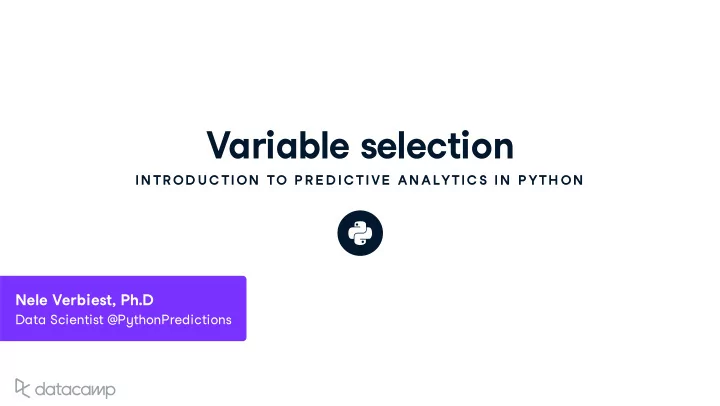

Variable selection IN TR OD U C TION TO P R E D IC TIVE AN ALYTIC S IN P YTH ON Nele Verbiest , Ph . D Data Scientist @ P y thonPredictions
Candidate predictors age max_gift income_low min_gift , mean_gift , median_gift country_USA , country_India , country_UK number_gift_min50 , number_gift_min100 , number_gift_min150 INTRODUCTION TO PREDICTIVE ANALYTICS IN PYTHON
Variable selection : moti v ation Dra w backs of models w ith man y v ariables : O v er -� � ing Hard to maintain or implement Hard to interpret , m u lti - collinearit y INTRODUCTION TO PREDICTIVE ANALYTICS IN PYTHON
Model e v al u ation : AUC import numpy as np from sklearn.metrics import roc_auc_score roc_auc_score(true_target, prob_target) INTRODUCTION TO PREDICTIVE ANALYTICS IN PYTHON
Let ' s practice ! IN TR OD U C TION TO P R E D IC TIVE AN ALYTIC S IN P YTH ON
For w ard step w ise v ariable selection IN TR OD U C TION TO P R E D IC TIVE AN ALYTIC S IN P YTH ON Nele Verbiest , Ph . D Data Scientist @ P y thonPredictions
The for w ard step w ise v ariable selection proced u re Empt y set Find best v ariable v 1 Find best v ariable v in combination w ith v 2 1 Find best v ariable v in combination w ith v , v 3 1 2 ... ( Until all v ariables are added or u ntil prede � ned n u mber of v ariables is added ) INTRODUCTION TO PREDICTIVE ANALYTICS IN PYTHON
F u nctions in P y thon def function_sum(a,b): s = a + b return(s) print(function_sum(1,2)) 3 INTRODUCTION TO PREDICTIVE ANALYTICS IN PYTHON
Implementation of the for w ard step w ise proced u re F u nction auc that calc u lates AUC gi v en a certain set of v ariables F u nction best_next that ret u rns ne x t best v ariable in combination w ith c u rrent v ariables Loop u ntil desired n u mber of v ariables INTRODUCTION TO PREDICTIVE ANALYTICS IN PYTHON
Implementation of the AUC f u nction from sklearn import linear_model from sklearn.metrics import roc_auc_score def auc(variables, target, basetable): X = basetable[variables] y = basetable[target] logreg = linear_model.LogisticRegression() logreg.fit(X, y) predictions = logreg.predict_proba(X)[:,1] auc = roc_auc_score(y, predictions) return(auc) auc = auc(["age","gender_F"],["target"],basetable) print(round(auc,2)) 0.54 INTRODUCTION TO PREDICTIVE ANALYTICS IN PYTHON
Calc u lating the ne x t best v ariable def next_best(current_variables,candidate_variables, target, basetable): best_auc = -1 best_variable = None for v in candidate_variables: auc_v = auc(current_variables + [v], target, basetable) if auc_v >= best_auc: best_auc = auc_v best_variable = v return best_variable current_variables = ["age","gender_F"] candidate_variables = ["min_gift","max_gift","mean_gift"] next_variable = next_best(current_variables, candidate_variables, basetable) print(next_variable) min_gift INTRODUCTION TO PREDICTIVE ANALYTICS IN PYTHON
The for w ard step w ise v ariable selection proced u re candidate_variables = ["mean_gift","min_gift","max_gift", "age","gender_F","country_USA","income_low"] current_variables = [] target = ["target"] max_number_variables = 5 number_iterations = min(max_number_variables, len(candidate_variables)) for i in range(0,number_iterations): next_var = next_best(current_variables,candidate_variables,target,basetable) current_variables = current_variables + [next_variable] candidate_variables.remove(next_variable) print(current_variables) ['max_gift', 'mean_gift', 'min_gift', 'age', 'gender_F'] INTRODUCTION TO PREDICTIVE ANALYTICS IN PYTHON
Let ' s practice ! IN TR OD U C TION TO P R E D IC TIVE AN ALYTIC S IN P YTH ON
Deciding on the n u mber of v ariables IN TR OD U C TION TO P R E D IC TIVE AN ALYTIC S IN P YTH ON Nele Verbiest , Ph . D Data Scientist @ P y thonPredictions
E v al u ating the AUC auc_values = [] variables_evaluate = [] for v in variables_forward: variables_evaluate.append(v) auc_value = auc(variables_evaluate, ["target"], basetable) auc_values.append(auc_value) INTRODUCTION TO PREDICTIVE ANALYTICS IN PYTHON
E v al u ating the AUC INTRODUCTION TO PREDICTIVE ANALYTICS IN PYTHON
O v er - fitting INTRODUCTION TO PREDICTIVE ANALYTICS IN PYTHON
Detecting o v er - fitting INTRODUCTION TO PREDICTIVE ANALYTICS IN PYTHON
Partitioning from sklearn.cross_validation import train_test_split X = basetable.drop("target", 1) y = basetable["target"] X_train, X_test, y_train, y_test = train_test_split(X, y, test_size=0.4, stratify = Y) train = pd.concat([X_train, y_train], axis=1) test = pd.concat([X_test, y_test], axis=1) INTRODUCTION TO PREDICTIVE ANALYTICS IN PYTHON
Deciding the c u t - off High test AUC Lo w n u mber of v ariables INTRODUCTION TO PREDICTIVE ANALYTICS IN PYTHON
Deciding the c u t - off INTRODUCTION TO PREDICTIVE ANALYTICS IN PYTHON
Let ' s practice ! IN TR OD U C TION TO P R E D IC TIVE AN ALYTIC S IN P YTH ON
Recommend
More recommend